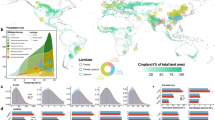Abstract
In many rainfed areas a rainy season crop is followed by a post rainy season (rabi) crop and the yield of the latter is directly related to the profile-stored water at the time of its sowing. Mulching is known to help increase soil moisture storage. The yields of dryland crops are also limited by availability of nutrients, particularly nitrogen. We studied the effect of organic mulching in rainy season maize or fallow on the yield of maize and the yield and water use efficiency (WUE) of the following wheat fertilized with different rates of N.
Mulching increased yield of maize by 9–12% and that of the following wheat by 25–28%. The increase in wheat yield with mulching in the previous crop of maize is attributable to greater residual moisture after maize particularly in the seed-zone and enrichment of soil with nutrients. In wheat following mulched maize, the yields with 0 and 40 kg N ha−1 were comparable to those with 40 and 80 kg N ha−1 in the absence of mulch. For a given N rate the yield of wheat was a function of available water supply. The yield increased with water supply up to a certain level beyond which it decreased with additional water supply. The threshold water supply and the corresponding yield increased with increase in N rate. Favourable effects of mulching in maize on the yield of wheat decreased with increase in water supply. The results suggest that to achieve optimum yield of wheat in double cropping the previous crop should be mulched and the N rate for wheat should be chosen in relation to available water supplies.
Similar content being viewed by others
References
Beale OW, Nutt GB and Peele TC (1955) The effects of mulch tillage on runoff, erosion, soil properties and crop yields. Soil Sci Soc Am Proc 19, 244–247
Jacks GV, Brind WD and Smith R (1955) Commonwealth Bur Soil Sci (Gt Brit) Tech Comm No 49 (cf. Adv Agron (1961) 13, 126–194)
Prihar SS and Hundal SS (1971) Determination of bulk density of soil clod by saturation. Geoderma 5, 283–286
Prihar SS and Singh R (1979) Fertilizer use in rabi crops under rainfed and limited moisture conditions. Indian Farming 29 (7) 44–49
Prihar SS, Singh R, Singh N and Sandhu KS (1979) Effects of mulching previous crops or fallow on dryland maize and wheat. Exp Agric 15, 129–135
Singh R, Singh Y, Prihar SS and Singh P (1975) Effects of N fertilization on yield and water use efficiency of dryland wheat as affected by stored water and rainfall. Agron J 67, 599–603
Verma HN, Prihar SS, Singh R and Singh N (1978) Yields of sub-humid rainfed crops in relation to soil water retentivity and cropping sequences. Exp Agric 14, 253–259
Zingg AW and Whitfield CJ (1957) US Dept Agric Tech Bull 1166, 1–56 (cf. Adv Agron (1961), 13, 126–194)
Author information
Authors and Affiliations
Rights and permissions
About this article
Cite this article
Prihar, S.S., Sandhu, K.S., Singh, Y. et al. Effect of N-rates on dryland wheat in relation to mulching previous crop or fallow. Fertilizer Research 2, 211–219 (1981). https://doi.org/10.1007/BF01834814
Issue Date:
DOI: https://doi.org/10.1007/BF01834814




